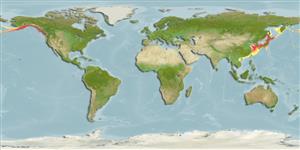>
Perciformes/Cottoidei (Sculpins) >
Agonidae (Poachers) > Hemitripterinae
Etymology: Hemitripterus: Greek, hemi = half + Greek, tres, tria = three + Greek, pteron = wing, fin (Ref. 45335).
More on author: Pallas.
Environment: milieu / climate zone / depth range / distribution range
Ökologie
seewasser demersal; tiefenbereich 0 - 550 m (Ref. 50550). Temperate; 66°N -
Northwest Pacific: Karaginskiy and Commander islands, Bering Sea to Okhotsk and Japan seas; one record from the western Gulf of Alaska.
Size / Gewicht / Alter
Maturity: Lm ? range ? - ? cm
Max length : 35.0 cm SL Männchen/unbestimmt; (Ref. 559)
Kurzbeschreibung
Morphologie | Morphometrie
Rückenflossenstacheln (insgesamt): 17 - 19; Rückenflossenweichstrahlen (insgesamt): 11-13; Afterflossenstacheln 0; Afterflossenweichstrahlen: 12 - 15. Body covered with many small tubercles; head large, with numerous bony humps and ridges; spinous dorsal fin deeply emarginate, its base longer than that of the soft dorsal fin; jaws, prevomer and palatines with broad bands of conical teeth (Ref. 559).
Life cycle and mating behavior
Geschlechtsreife | Fortpflanzung | Ablaichen | Eier | Fecundity | Larven
Spawn in the calcareous deposits of colonies of the polychaeta, Salmacinasp. which makes them more of 'cavity spawners' than 'spawners in live vertebrate' (Ref. 34819, 26281).
Eschmeyer, W.N., E.S. Herald and H. Hammann, 1983. A field guide to Pacific coast fishes of North America. Boston (MA, USA): Houghton Mifflin Company. xii+336 p. (Ref. 2850)
IUCN Rote Liste Status (Ref. 130435)
Bedrohung für Menschen
Harmless
Nutzung durch Menschen
Mehr Information
ReferenzenAquakulturAquakultur ProfilZuchtlinienGenetikElectrophoresesVererbbarkeitKrankheitenVerarbeitungNutrientsMass conversion
PartnerBilderStamps, Coins Misc.LauteCiguateraGeschwindigkeitSchwimmstilKiemenoberflächeOtolithsGehirngrößeSehfähigkeit
Tools
Zusatzinformationen
Download XML
Internet Quellen
Estimates based on models
Preferred temperature (Ref.
123201): 0.9 - 11, mean 4.7 °C (based on 411 cells).
Phylogenetic diversity index (Ref.
82804): PD
50 = 0.6289 [Uniqueness, from 0.5 = low to 2.0 = high].
Bayesian length-weight: a=0.01096 (0.00493 - 0.02437), b=3.06 (2.86 - 3.26), in cm total length, based on LWR estimates for this species & (Sub)family-body (Ref.
93245).
Trophic level (Ref.
69278): 4.3 ±0.4 se; based on diet studies.
Widerstandsfähigkeit (Ref.
120179): niedrig, Verdopplung der Population dauert 4,5 - 14 Jahre. (Preliminary K or Fecundity.).
Fishing Vulnerability (Ref.
59153): Low to moderate vulnerability (33 of 100).
